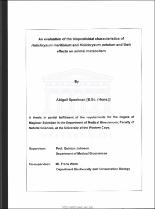| dc.description.abstract | There are a number of pesticides that are suspected to be endocrine disrupters Many of these pesticides are man-made. Endocrine disrupters are chemicals that can lead to an increase in birth defects, sexual abnormalities, and reproductive failure. Marine animals seem to be the most vulnerable to the effects of pesticides since the ocean is the final sink for many pollutants. Endocrine disrupters can exert their effects in many ways. They can either bind to the hormone's receptor and mimic the hormone, or block the action of the hormone' An experiment done of newborn female rats injected with 1mg DDT/day on days 2-4 after birth had early onset of puberty and accelerated loss of fertility. In
another experiment, vinclozolin (also a pesticide) at dosage levels of 3mg/kg/day resulted in feminized male rats in the womb, and an abnormal number of nipples were observed (11). Pesticides can be absorbed through the skin, by inhalation or oral ingestion. There are, however, important quantitative differences between the various derivatives. The skin poorly absorbs DDT in solution, whereas dieldrin absorption by the skin is very efficient. The major effects of insecticides in humans are qualitatively similar and cause effects on the central nervous system (9). Endocrine disrupters encompass more than just environmental estrogens and include any agent that adversely affects any aspect of the entire endocrine system. Endocrine disrupters are usually either natural products or synthetic chemicals that mimic, enhance, or inhibit the action of natural hormones (5). Low levels of many endocrine-disrupting chemicals can lead to high levels in the body
tissues of animals and humans. This is due to the fact that many endocrine disrupters are stored in fat tissues through biomagnifications (2). | en_US |

